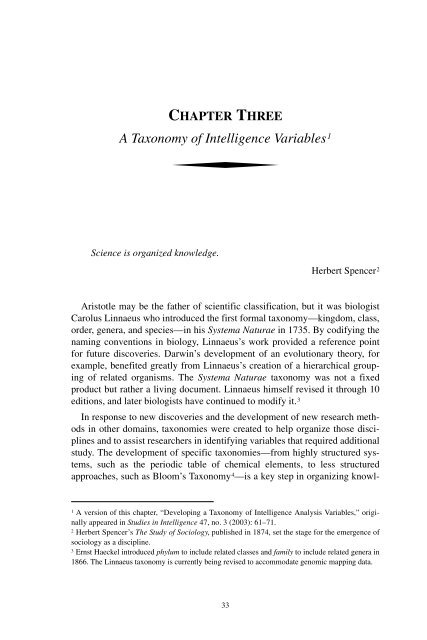Analytic Culture in the U.S. Intelligence Community (PDF) - CIA
Analytic Culture in the U.S. Intelligence Community (PDF) - CIA
Analytic Culture in the U.S. Intelligence Community (PDF) - CIA
You also want an ePaper? Increase the reach of your titles
YUMPU automatically turns print PDFs into web optimized ePapers that Google loves.
CHAPTER THREE<br />
A Taxonomy of <strong>Intelligence</strong> Variables 1<br />
Science is organized knowledge.<br />
Herbert Spencer 2<br />
Aristotle may be <strong>the</strong> fa<strong>the</strong>r of scientific classification, but it was biologist<br />
Carolus L<strong>in</strong>naeus who <strong>in</strong>troduced <strong>the</strong> first formal taxonomy—k<strong>in</strong>gdom, class,<br />
order, genera, and species—<strong>in</strong> his Systema Naturae <strong>in</strong> 1735. By codify<strong>in</strong>g <strong>the</strong><br />
nam<strong>in</strong>g conventions <strong>in</strong> biology, L<strong>in</strong>naeus’s work provided a reference po<strong>in</strong>t<br />
for future discoveries. Darw<strong>in</strong>’s development of an evolutionary <strong>the</strong>ory, for<br />
example, benefited greatly from L<strong>in</strong>naeus’s creation of a hierarchical group<strong>in</strong>g<br />
of related organisms. The Systema Naturae taxonomy was not a fixed<br />
product but ra<strong>the</strong>r a liv<strong>in</strong>g document. L<strong>in</strong>naeus himself revised it through 10<br />
editions, and later biologists have cont<strong>in</strong>ued to modify it. 3<br />
In response to new discoveries and <strong>the</strong> development of new research methods<br />
<strong>in</strong> o<strong>the</strong>r doma<strong>in</strong>s, taxonomies were created to help organize those discipl<strong>in</strong>es<br />
and to assist researchers <strong>in</strong> identify<strong>in</strong>g variables that required additional<br />
study. The development of specific taxonomies—from highly structured systems,<br />
such as <strong>the</strong> periodic table of chemical elements, to less structured<br />
approaches, such as Bloom’s Taxonomy 4 —is a key step <strong>in</strong> organiz<strong>in</strong>g knowl-<br />
1<br />
A version of this chapter, “Develop<strong>in</strong>g a Taxonomy of <strong>Intelligence</strong> Analysis Variables,” orig<strong>in</strong>ally<br />
appeared <strong>in</strong> Studies <strong>in</strong> <strong>Intelligence</strong> 47, no. 3 (2003): 61–71.<br />
2<br />
Herbert Spencer’s The Study of Sociology, published <strong>in</strong> 1874, set <strong>the</strong> stage for <strong>the</strong> emergence of<br />
sociology as a discipl<strong>in</strong>e.<br />
3<br />
Ernst Haeckel <strong>in</strong>troduced phylum to <strong>in</strong>clude related classes and family to <strong>in</strong>clude related genera <strong>in</strong><br />
1866. The L<strong>in</strong>naeus taxonomy is currently be<strong>in</strong>g revised to accommodate genomic mapp<strong>in</strong>g data.<br />
33
















